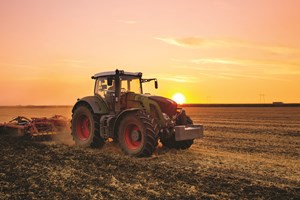 Agricultural tractors
Agricultural tractorsAn agricultural tractors is defined as a 4-wheeled or tracklaying automotive vehicle used for pulling farm equipment. The vehicle has no body apart from a cab and consists of two or more axles. The definition is typically inclusive of wheeled and crawler tractors.
The lower size limit of tractors included in Off-Highway Research’s data depends from region to region. There is no upper limit to the size of tractors covered.
Single axle walking tractors, power tillers, small tractors with a simple belt drive transmission or single cylinder engine are not included in Off-Highway Research’s analysis.
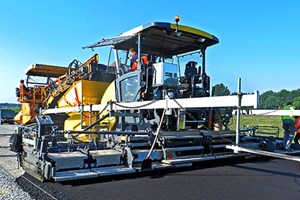 Asphalt pavers
Asphalt paversAsphalt pavers are used to distribute and lay asphalt on surfaces such as bridges and roads. Both crawler and wheeled types are included in Off-Highway Research’s reports. Most asphalt pavers are self-propelled / diesel fuelled while some are towed by the machine that provides the asphalt. The components of a paver include a tractor or other such machine to drive it forward, an engine including hydraulic drives and controls, drive wheels or tracks, a hopper for receiving the asphalt, feeder conveyors and distribution augers.
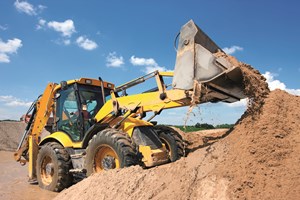 Backhoe loaders
Backhoe loadersThe backhoe loader was originally developed by modifying agricultural or industrial tractors. They include a front loader bucket and a rear hydraulic excavator arm. They typically have a rigid chassis, although articulated models are available, and most fall in the 40-100 horsepower range, with both 2 wheel and 4 wheel-drive options available.
 Compact tracked loaders
Compact tracked loadersThe compact tracked loader is a tracked variant of the wheeled skid-steer. Both machines’ overall appearance, structure and function are similar. The defining difference is the tracked undercarriage of a compact tracked loader. These machines were first developed in the late 1980s and early 1990s, and started to become widely available in the 2000s.
The tracked undercarriage exerts less pressure on the ground than the wheels of a skid steer loader. This allows compact tracked loaders to operate in softer ground conditions, or in applications where a wheeled machine may damage the terrain.
Compact tracked loaders are usually classified by their rated operating capacity, which is to say the heaviest load a machine can lift without tipping onto its nose.
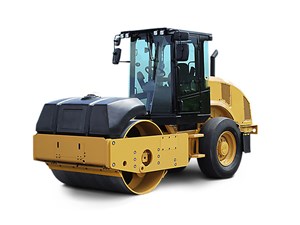 Compaction equipment
Compaction equipment Off-Highway Research’s coverage of compaction equipment small hand-guided equipment as well as various types of larger ride-on equipment. The main types of compaction equipment within our coverage are:
Hand-guided equipment, including one-way and reversible types.
Sometimes called hand-guided, duplex or walk-behind rollers, they comprise one or two vibrating rollers with a typical width of 650 mm or less.
Equipped with two vibrating drums, these machines are either articulated or have a rigid frame with skid-steering split drums. Typical drum widths are 650-850 mm and they feature remote control to allow them to be used in applications where it would be dangerous or illegal to deploy personnel.
Ride-on tandem rollers have two drums and, depending upon their specification, either one or both drums will vibrate or oscillate. They come in a wide range of sizes from 0.9 to 16.5 tonnes, and are used primarily for compacting asphalt. The frame may be rigid or articulated, and there may be drives to one or both drums. Some models have split drums for better finishing on curves.
Self-propelled rollers, or soil compactors, have a single drum at the front and a driven steering axle with treaded tyres at the rear. The front drum may also be driven. It may be of smooth steel or rubber-coated for asphalt, or pad foot for earth compaction.
Pneumatic-tyred rollers (PTRs) rely purely on their weight and in consequence are ballasted. Their function is to bring the finer particles to the surface of an asphalt mix and to leave a completely smooth surface, which will not ripple as the final vibratory tandem roller, seals it.
Combination rollers, or combi rollers,have one smooth, vibrating steel drum at the front, and a set of smooth rubber tyres at the rear. Combining aspects of PTRs and tandem rollers into a single machine has the attraction of offering both high compaction and a high quality finish.
Towed rollers are usually used with crawler dozers. They carry a small engine to power the vibrator.
Static rollers are non-vibrating and with a single drum on the front and two at the rear. The weight of the machine can be increased by adding ballast such as water, sand or a mixture of both to aid their ability to compact material.
 Crawler dozers
Crawler dozersCrawler dozers are continuous tracked machines fitted with front-mounted blades to move or push large quantities of material such as soil, sand and rubble. Attached to the back of a crawler dozer is a ripper to break and loosen compacted materials. Crawler dozers have engines from 45 to over 700 horsepower.
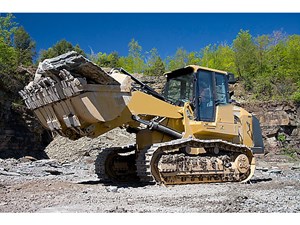 Crawler loaders
Crawler loadersA crawler loader has a tracked chassis with a front loader used for digging and loading material. The defining difference between a crawler loader and crawler dozer is that a crawler loader has a rear-mounted engine to counterbalance the load in the bucket, while a dozer has a front-mounted engine to move the centre of gravity forward and aid with the pushing of material.
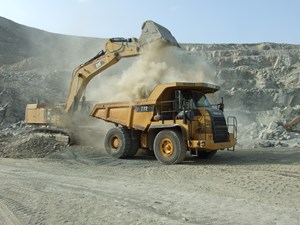
Dump trucks feature open bodies which are hinged at the rear, with hydraulic cylinders to lift them from the front and allow material to be emptied behind the truck. Less commonly, a material ejection system may be fitted to allow material to be discharged without raising the body.
Rigid dump trucks have a rigid/fixed chassis and traditional steering systems.The main attributes of a rigid dump truck are its simple construction, reliability and longevity.
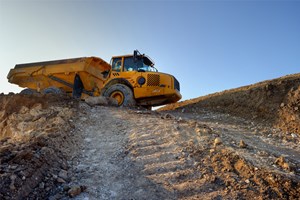
Articulated dump trucks feature an articulated chassis and an articulation point directly behind the cab. These machines turn by pivoting at the articulation point known as articulated steering.
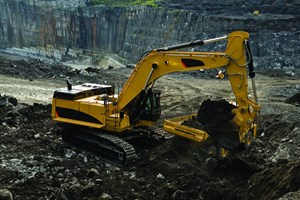 Excavators - crawler and wheeled
Excavators - crawler and wheeledExcavators consist a bucket mounted on a two or three-piece boom and stick assembly, on a rotating platform with the operator’s cab, engine compartment and hydraulic pump. All movement and operation is achieved through hydraulic
systems. Beneath the rotation point (slewing ring), excavators may be mounted on either a crawler (tracked) or wheeled undercarriage.
Off-Highway Research’s definition of a hydraulic excavator is a machine with an operating weight of 6 tonnes or more. Machines smaller than this are classified as mini excavators.
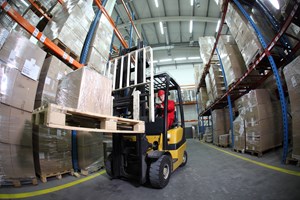 Industrial forklift trucks
Industrial forklift trucksIndustrial forklift trucks are are typically powered by internal combustion engines or electric motors. The former are referred to as IC forklifts and the latter as electric forklifts. With regards to IC trucks, the fuel used can be diesel, gasoline or liquefied petroleum gas (LPG).
They are usually fitted with fork attachments mounted on a vertical mast. These are primarily designed to lift and carry palletised loads and other materials with suitable lifting slots.
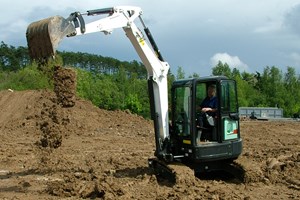 Mini excavators
Mini excavatorsMini excavators are compact machines with an operating weight of less than 6 tonnes. The machines may be mounted on tracks or wheels, with the upper body and digging equipment being capable of being turned through 360 degrees. Off-Highway Research classifies mini excavators as being in the range of 0.8-6.0 tonnes.
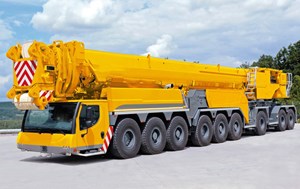 Mobile cranes
Mobile cranesOff-Highway Research covers the following types of mobile cranes:
All terrain cranes are designed to have the road-going mobility of a truck mounted crane as well as the ability to operate in rough terrain conditions. Featuring a truck chassis, they have similarities to truck-mounted cranes, but are differentiated by large tyres to provide ground clearance and off-road mobility, a multi-axle chassis and all-wheel drive and steering.
These machines are mounted on crawler chassis and are generally fitted with lattice booms on a slewing upper structure.
These machines are often referred to as self-propelled or yard cranes, and can be fitted with either telescopic or lattice booms. They are small, general purpose material handling cranes with a low travel speed, designed for use in firm ground conditions.
Pick & carry cranes are unique to India and surrounding countries. They feature a non-slewing design with a rear-mounted, forward-facing boom. The chassis usually comprises a rear two-wheeled tractor unit, connected via an articulation joint to non-driven, front axle which also supports the boom. They are therefore two-wheel drive machines, which are steered by means of pivoting about the articulation point. Lifting capacities are typically 25 tonnes or less.
Although now purpose-built as pick & carry cranes, the original models made use of a disused tractor or backhoe loader for the rear drive unit.
Rough terrain cranes invariably have two axles and feature high ground clearance and high floatation tyres for off-road manoeuvrability, which is also aided by all-wheel driving and steering. It is not usually permissible to drive rough terrain cranes on public highways, although there are exceptions in certain countries.
These machines predominantly have telescopic booms, although they are also available with lattice booms. They are designed to travel on public highways and are often based on, or mounted on commercially available truck chassis. They are powered by a diesel engine and employ hydraulic systems to drive the boom and lifting gear.
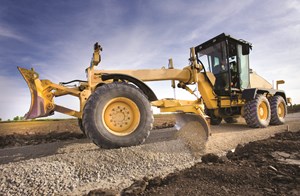 Motor graders
Motor gradersMotor graders feature a long, mid-mounted blade which is used to create level or angled surfaces in the material being shaped. Most graders have three axles – two at the back and one at the front - featuring a cab and engine above the rear two.
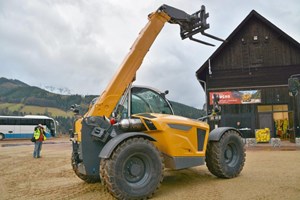 Telescopic handlers
Telescopic handlersTelescopic handlers two axle machines for materials handling on unimproved ground. They feature a telescopic boom which can be fitted with a variety of attachments, including pallet forks, buckets and access platforms, which combine with their vertical and horizontal reach capabilities to provide a versatile machine
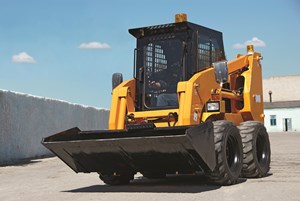 Skid-steer loaders
Skid-steer loadersThe skid-steer loader is a compact four-wheel drive machine designed to operate in restricted areas. It is distinguished by its steering system. Steering is achieved by independently varying the speed and direction of the two sets of wheels on either side.
Skid steer loaders are usually classified by their rated operating capacity, which is to say the heaviest load a machine can lift without tipping onto its nose.
Track-mounted variants of the skid –steer loader – usually referred to as compact tracked loaders – are considered to be a different machine type.
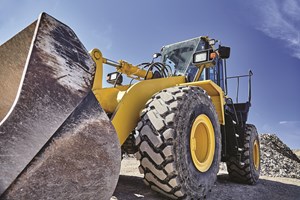 Wheeled loaders
Wheeled loadersA wheeled loader is a 4-wheel drive articulated machine, powered by a diesel engine. It has a front mounted bucket connected to a boom to collect material from the ground. The purpose is to transfer this material from one place to another without pushing it along the ground.
Off-Highway Research classifies wheeled loaders in two distinct types. Compact wheeled loaders from 30-80 horsepower and larger machines of 80 horsepower or more.
|
KHL Media Limited © Off-Highway Research 2025 All right reserved |
About Us Privacy Policy |
Contact Us Terms & Conditions |